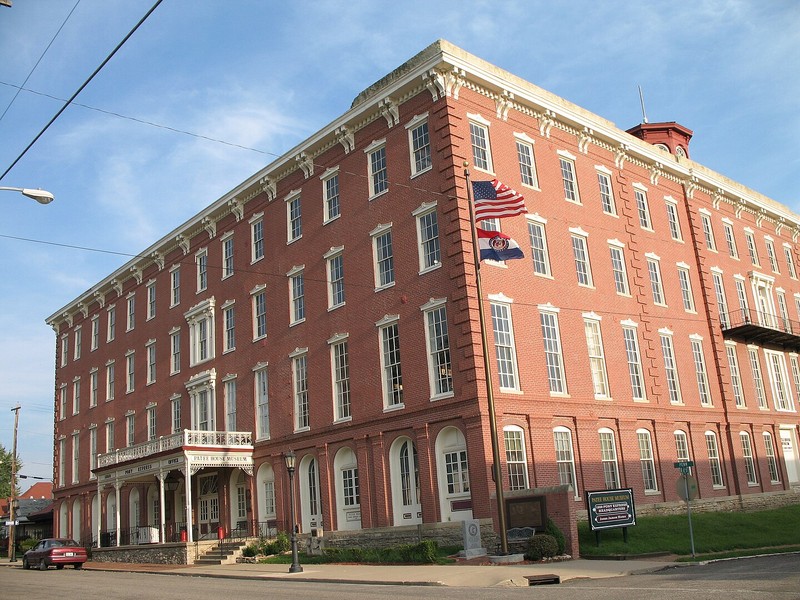Patee House Museum
Introduction
Text-to-speech Audio
Two things for which St. Joseph enjoys historical significance are its role as a Pony Express launch point and the city where a gunshot ended Jesse James' life. The Patee House, which sits adjacent to the James Home and Museum, opened as a luxurious 140-room hotel that served as the Pony Express Missouri No. 2 Eastern Headquarters two years after it opened in 1858. John Patee built the lavish hotel that quickly earned a reputation as the most luxurious hotel west of the Mississippi River. The hotel arose as part of an entire community planned by Patee, intended to compete with the downtown area. However, the Civil War and other factors thwarted that dream. After the war, the building served numerous functions, including a women's college, hotel, shirt factory, and lastly, a museum.
Images
Patee House Museum

Backstory and Context
Text-to-speech Audio
In 1856, John Patee began constructing what became regarded as one of the most luxurious hotels in the American West. The hotel idea existed as part of a grander plan known as "Patee Town," which Patee hoped would compete against St. Joesph's downtown region. Indeed, Patee owned several other businesses throughout St. Joseph. He opened the first drugstore and owned several lots and houses that he rented out.
Several factors led John Patee to build the hotel. Demand for lodging in St. Joseph was high. By the time of its construction, railroad lines and riverboats connected St. Joseph to the East, while those seeking to go west by stagecoach could follow overland trails. Indeed, the Patee House, which opened in 1858, became the starting point for a daily stagecoach to Placerville, California, and the beginning of a stagecoach line from St. Joseph to Salt Lake City, Utah.
In addition to stagecoach guests, the hotel served railroad companies and guests, as well as the newly-created Pony Express. In 1859, the Hannibal & St. Joseph Railroad, whose line had just arrived in St. Joseph, opened offices in the Patee House, and then one year later, Russell, Majors, & Waddell established the St. Joseph offices of Central Overland California and Pikes Peak Express Company on the first floor. A ceremonial cannon fired in front of the hotel on April 3, 1860, inaugurated the first ride of the Pony Express from St. Joesph to California. The hotel served both as the starting point and trail's end of the Pony Express 2,000-mile journey, which took roughly one and half weeks to complete. The Pony Express' life proved short-lived because one year later, in October of 1861, the transcontinental telegraph spelled the end of the operation.
The Civil War also started in 1861. Although Patee supported the Confederacy, his hotel became home to the Union Army, which established its provost marshal's office and recruiting office in the building. In 1865, when the war left the hotel in a failing financial condition, Patee held a lottery to sell the hotel. He sold tickets throughout the U.S. for $2 each. However, a lack of interest allowed Patee to buy 100 unsold tickets. As luck would have it, Patee drew the winning ticket and regained the hotel he intended to sell.
Still, lottery luck aside, Patee's vision of operating a luxury hotel within "Patee Town" lasted only a short time, from 1858 to 1865. Mounting debt, issues tied to the war, and Patee's realization that his hotel could not compete with similar operations located in the town's business district led him to rethink the purpose of his hotel. Thus, after the Civil War, the building transitioned into a Methodist women's college, followed by numerous other roles. The building's many identities include:
- Patee Hotel, 1858-1865
- Patee Female College, 1865-1868
- Patee Hotel (again), 1869-1872
- St. Joseph Female College, 1875-1880
- World's Hotel and Epileptic Sanitarium, 1881-1883
- R.L. McDonald Factory, 1885-1933
- Sun Garment Factory, 1933-1953
- H.D. Lee Company, 1953-1957
- From 1857 to 1965, the Patee House largely stood vacant.
- Patee House Museum, 1965-present
In 1882, operating as the World's Hotel, the Patee House became connected to the death of Jesse James. James' wife and children stayed at the Patee House in the aftermath of the shooting as investigators combed through the James home. Today, the two historic buildings operate as a pair of museums, with the Jesse James Home Museum adjacent to the Patee House.
Sources
Carneal, Thomas W. "Nomination Form: Jesse James House." National Register of Historic Places. mo.gov. September 4, 1980. https://dnr.mo.gov/shpo/nps-nr/80002319.pdf.
Chan, Amy. "The Patee House in St. Joseph, Missouri, was Headquarters for the Pony Express." HistoryNet. May 10, 2018. https://www.historynet.com/patee-house-st-joseph-missouri-headquarters-pony-express/.
Hopkins, John L and Oates, Marsha R. "Registration Form: Patee Town Historic District." National Register of Historic Places. mostateparks.com. June 2, 2011. https://mostateparks.com/sites/mostateparks/files/Patee%20Town%20HD.pdf.
Lissandrello, Stephen. "Nomination Form: Patee House." National Register of Historic Places. mo.gov. October 15, 1966. https://dnr.mo.gov/shpo/nps-nr/66000414.pdf.
"The Patee House." Patee House Museum. Accessed February 8, 2019. http://ponyexpressjessejames.com/our-history.
Patee House Museum. St. Joseph Missouri. stjosephmo.gov. Accessed July 17, 2024. https://www.stjosephmo.gov/369/Patee-House-Museum
Powers, Mathew and Clio Admin. "Jesse James Home Museum." Clio: Your Guide to History. July 17, 2024. Accessed July 19, 2024. https://theclio.com/entry/183600
CC BY-SA 2.5, https://commons.wikimedia.org/w/index.php?curid=1118561
